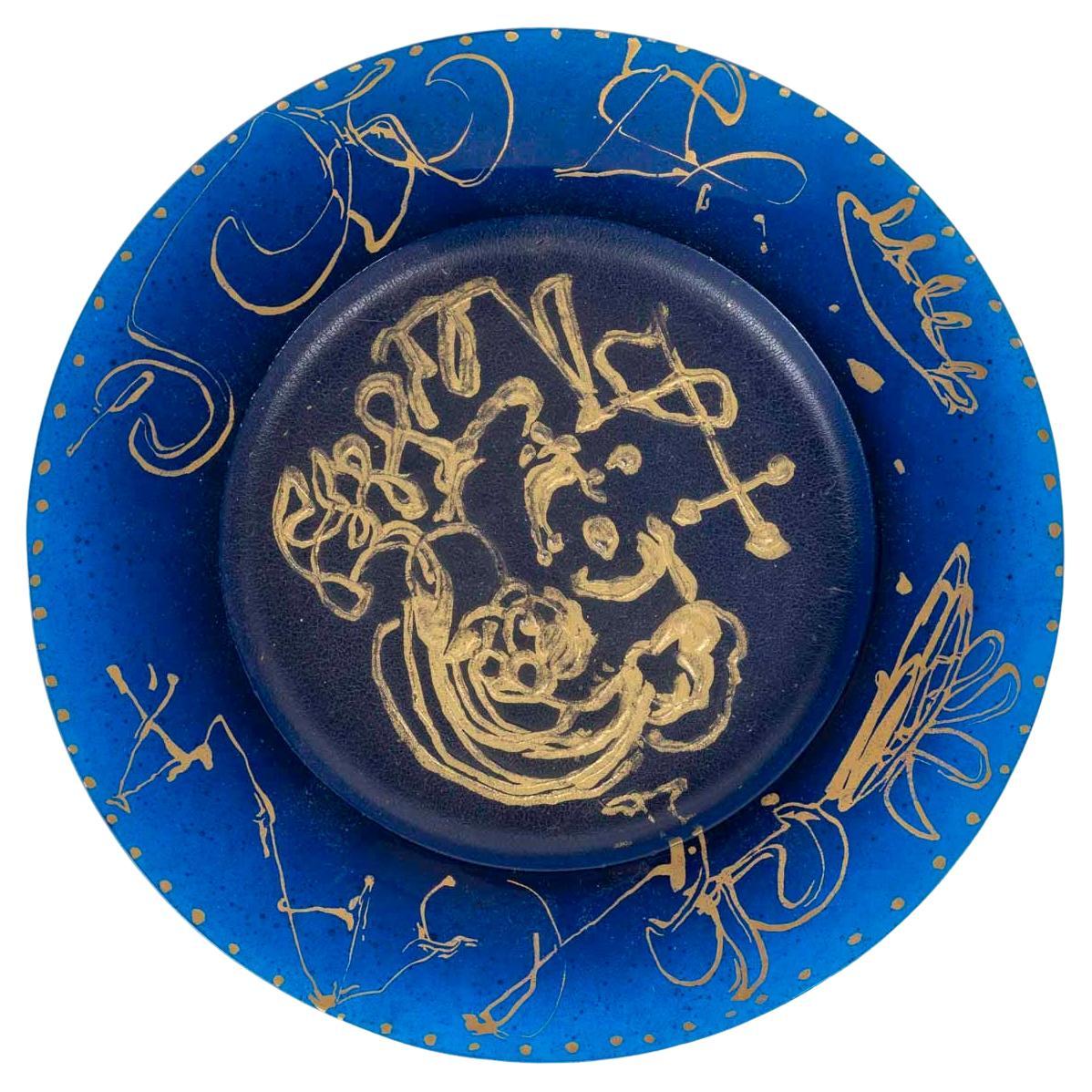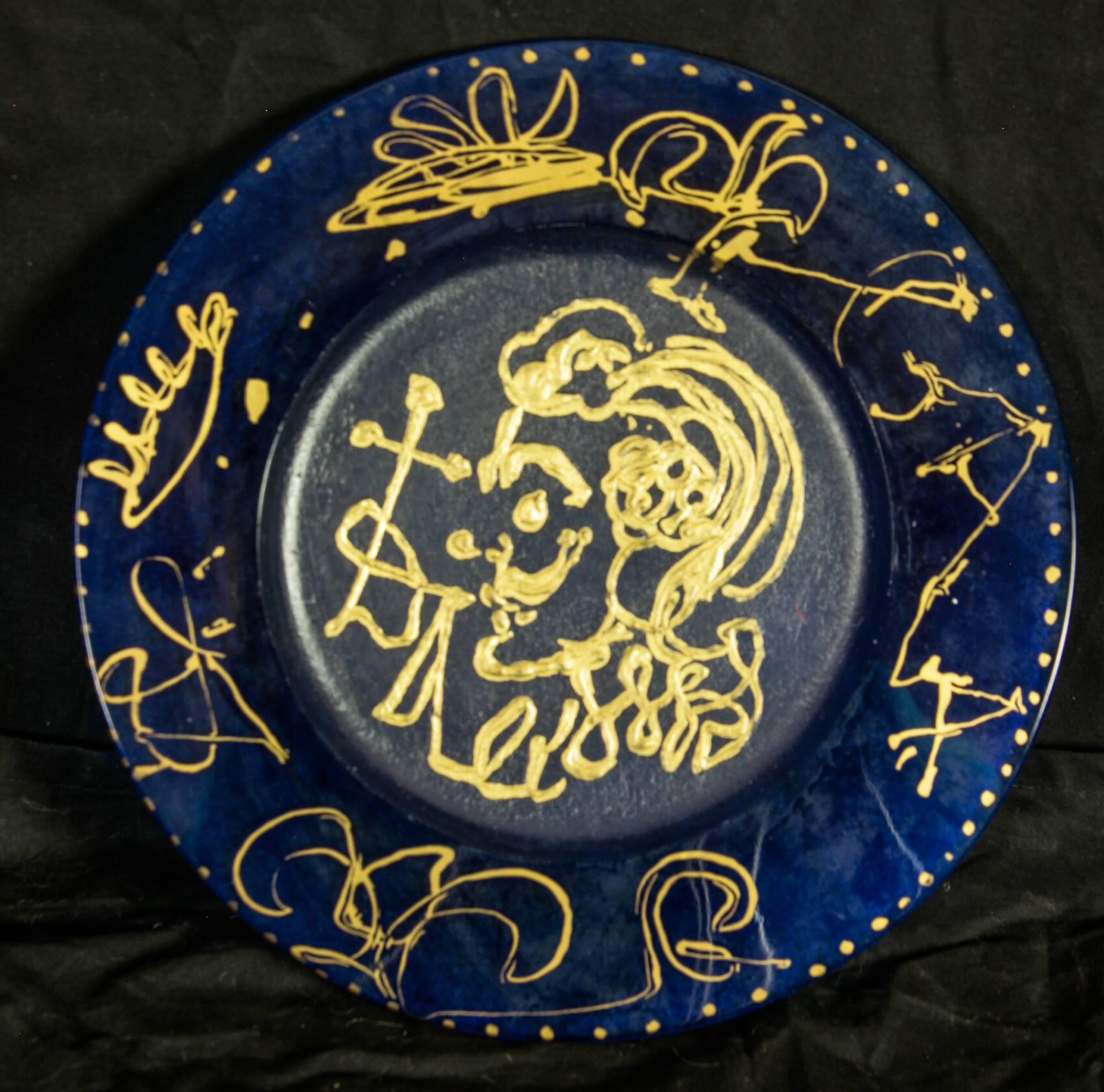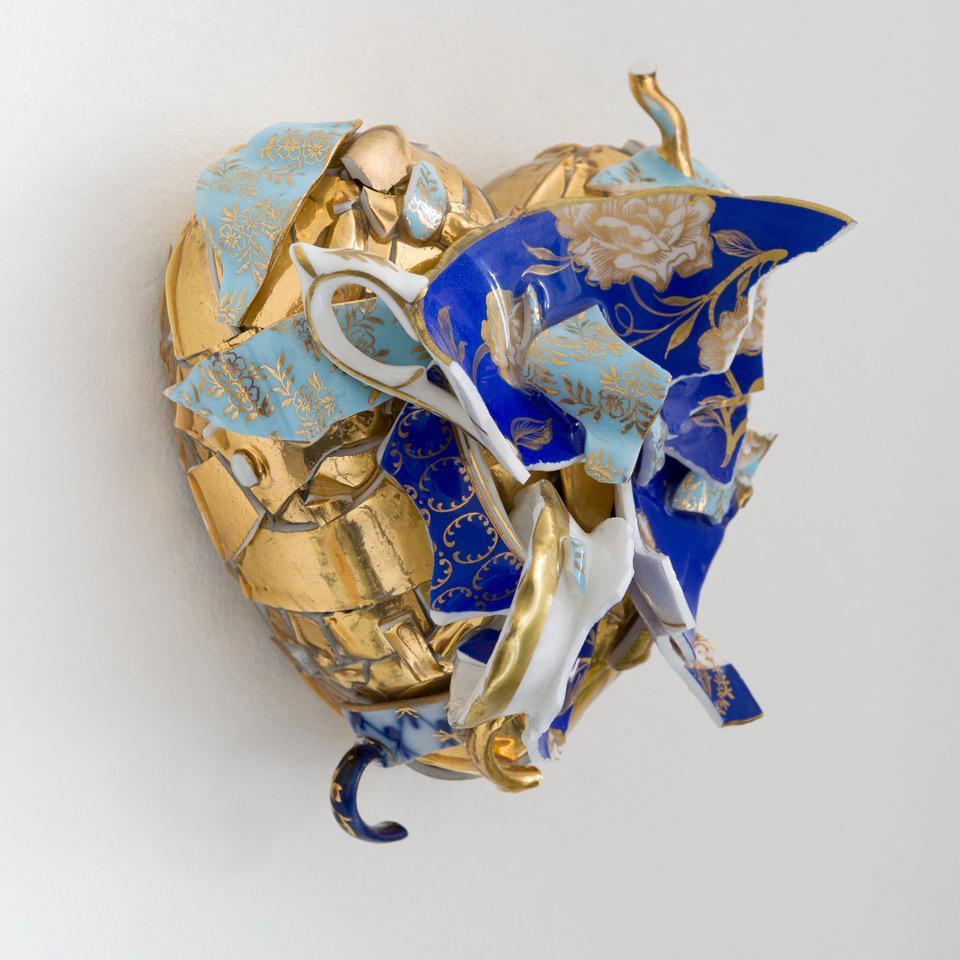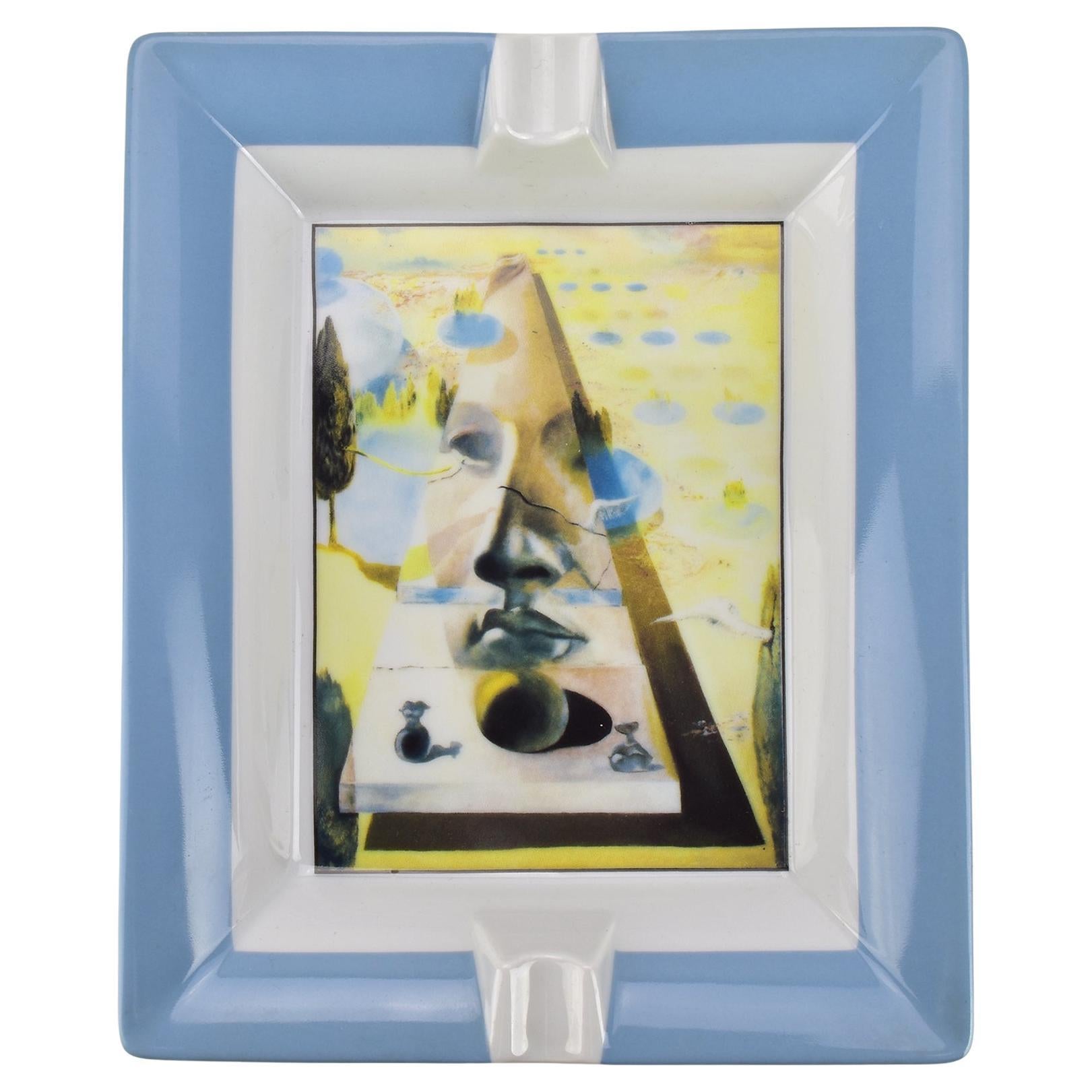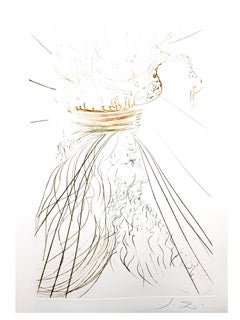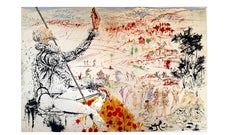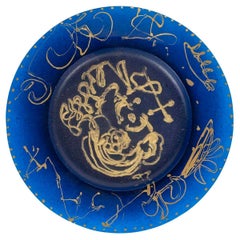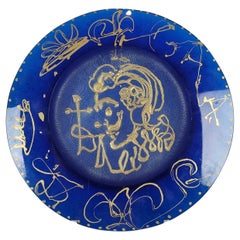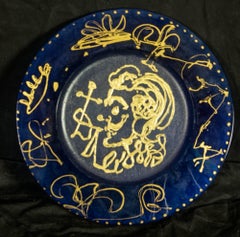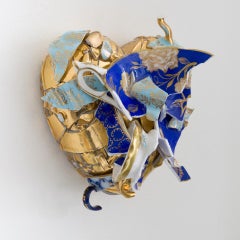Items Similar to Faust - Limoges Porcelain Blue and Gold
Want more images or videos?
Request additional images or videos from the seller
1 of 9
(after) Salvador DaliFaust - Limoges Porcelain Blue and Gold1968
1968
$1,802.14
£1,319.72
€1,500
CA$2,453.16
A$2,749.68
CHF 1,431.68
MX$33,574.72
NOK 18,177.08
SEK 17,230.23
DKK 11,415.46
Shipping
Retrieving quote...The 1stDibs Promise:
Authenticity Guarantee,
Money-Back Guarantee,
24-Hour Cancellation
About the Item
Limoges porcelain in "Bleu de Sèvres" and gold.
Artist: Salvador Dali
Exclusive limited edition to 2000 copies "Raynaud & Co. Limoges", France, 1968.
"Faust" drawn by Salvador Dalí. Print signed.
Plate Signed in the back of the plate
Dimensions: Diameter: 26 cm
Edited by Salins Earthenware
Sold in its original box
The company "Raynaud-Limoges" specialized in the production of porcelain products in small runs, among the company's customers - crowned people and representatives of the old aristocratic families of Europe.
Dali - the Prodigy Child without an Exam.
Salvador Dali was born as the son of a prestigious notary in the small town of Figueras in Northern Spain. His talent as an artist showed at an early age and Salvador Felipe Jacinto Dali received his first drawing lessons when he was ten years old. His art teachers were a then well known Spanish impressionist painter, Ramon Pichot and later an art professor at the Municipal Drawing School. In 1923 his father bought his son his first printing press.
Dali began to study art at the Royal Academy of Art in Madrid. He was expelled twice and never took the final examinations. His opinion was that he was more qualified than those who should have examined him.
In 1928 Dali went to Paris where he met the Spanish painters Pablo Picasso and Joan Miro. He established himself as the principal figure of a group of surrealist artists grouped around Andre Breton, who was something like the theoretical "schoolmaster" of surrealism. Years later Breton turned away from Dali accusing him of support of fascism, excessive self-presentation and financial greediness.
By 1929 Dali had found his personal style that should make him famous the world of the unconscious that is recalled during our dreams. The surrealist theory is based on the theories of the psychologist Dr. Sigmund Freud. Recurring images of burning giraffes and melting watches became the artist's surrealist trademarks. His great craftsmanship allowed him to execute his paintings in a nearly photo-realistic style. No wonder that the artist was a great admirer of the Italian Renaissance painter Raphael.
Salvador Dali and Gala.
Meeting Gala was the most important event in the artist's life and decisive for his future career. She was a Russian immigrant and ten years older than Dali. When he met her, she was married to Paul Eluard.
Gala decided to stay with Dali. She became his companion, his muse, his sexual partner, his model in numerous art works and his business manager. For him she was everything. Most of all Gala was a stabilizing factor in his life. And she managed his success in the 1930s with exhibitions in Europe and the United States.
Gala was legally divorced from her husband in 1932. In 1934 Dali and Gala were married in a civil ceremony in Paris and in 1958 in church after Gala's former husband had died in 1952. However from around 1965 on, the couple was seen less frequently together. But Gala continued to manage Dali's business affairs.
1933 Salvador Dali had his first one-man show in New York. One year later he visited the U.S. for the first time supported by a loan of US$500 from Pablo Picasso. To evade World War II, Dali chose the U.S.A. as his permanent residence in 1940. He had a series of spectacular exhibitions, among others a great retrospective at the Museum of Modern Art in New York.
Besides creating a number of great paintings, Dali caused the attention of the media by playing the role of a surrealist clown. He made a lot of money and was contemptuously nicknamed Avida Dollars (greedy for dollars) by Andre Breton.
Dali became the darling of the American High Society. Celebrities like Jack Warner or Helena Rubinstein gave him commissions for portraits. His art works became a popular trademark and besides painting he pursued other activities - jewelry and clothing designs for Coco Chanel or film making with Alfred Hitchcock.
The Classic Period After World War II
In 1948 Dali and Gala returned to Europe, spending most of their time either in their residence in Lligat or Spain or in Paris or France or in New York. Dali developed a lively interest in science, religion and history. He integrated things into his art that he had picked up from popular science magazines.
Another source of inspiration were the great classical masters of painting like Raphael, Velasquez or the French painter Ingres. The artist commented his shift in style with the words: "To be a surrealist forever is like spending your life painting nothing but eyes and noses."
In 1958 the artist began his series of large sized history paintings. He painted one monumental painting every year during the summer months in Lligat. The most famous one, The Discovery of America by Christopher Columbus, can be seen at the Dali Museum in St. Petersburg in Florida. It is breath-taking. The artist's late art works combine more than ever his perfect and meticulous painting technique with his fantastic and limitless imaginations.
Salvador Dali is the only known artist who had two museums dedicated exclusively to his works at lifetime.
Dali Museum in St. Petersburg, Florida
The Dali Museum in St. Petersburg in Florida or U.S.A. was founded in 1971 by the Dali collector A. Reynolds Morse and his wife Eleanor. The collection was first exhibited in a building adjacent to their home in Cleveland/Ohio.
In 1982, the museum was moved to St. Petersburg in Florida. It hosts 95 oil paintings including six of Dali's eighteen large-sized historical paintings.
Dali Museum-Theater in Figueres, Spain.
The Dali Museum-Theater in Figueres, Spain was the former Municipal Theater of Figueres. In 1918, when Salvador Dali was only fourteen years old, it had shown his first public exhibition.
Since 1970 the artist had dedicated his energy to transform the former Municipal Theater into a museum and art gallery. In 1974 the Theatro Museo Dali was officially opened.
1980 Dali was forced to retire due to palsy, a motor disorder, that caused a permanent trembling and weakness of his hands. He was not able to hold a brush any more. The fact that he could not follow his vocation and passion of painting and the news of Gala's death in 1982 left him with deep depressions.
After Gala's death he moved to Pubol, a castle, he had bought and decorated for Gala. In 1984, when he was lying in bed, a fire broke out and he suffered sever burns. Two years later, a pacemaker had to be implanted.
Towards the end of his life, Dali lived in the tower of his own museum where he died on January 23, 1989 from heart failure.
- Creator:(after) Salvador Dali (1904 - 1989, Spanish)
- Creation Year:1968
- Dimensions:Height: 0.79 in (2 cm)Width: 10.24 in (26 cm)Depth: 10.24 in (26 cm)
- Medium:
- Movement & Style:
- Period:
- Condition:
- Gallery Location:Collonge Bellerive, Geneve, CH
- Reference Number:1stDibs: LU16122565501
(after) Salvador Dali
Salvador Dali (1904 – 1989) was a Spanish surrealist artist renowned for his technical skill, precise draftsmanship and the striking and bizarre images in his work. Born in Figueres, Catalonia, Dali received his formal education in fine arts in Madrid. Influenced by Impressionism and the Renaissance masters from a young age, he became increasingly attracted to Cubism and avant-garde movements. He moved closer to Surrealism in the late 1920s and joined the Surrealist group in 1929, soon becoming one of its leading exponents. His best-known work, The Persistence of Memory, was completed in August 1931, and is one of the most famous Surrealist paintings. Dali lived in France throughout the Spanish Civil War (1936 to 1939) before leaving for the United States in 1940 where he achieved commercial success. He returned to Spain in 1948 where he developed his "nuclear mysticism" style, based on his interest in classicism, mysticism and recent scientific developments. Dali's artistic repertoire included painting, graphic arts, film, sculpture, design and photography, at times in collaboration with other artists. He also wrote fiction, poetry, autobiography, essays and criticism. Major themes in his work include dreams, the subconscious, sexuality, religion, science and his closest personal relationships. Some trends in Dali's work that would continue throughout his life were already evident in the 1920s. Dali was influenced by many styles of art, ranging from the most academically classic, to the most cutting-edge avant-garde. His classical influences included Raphael, Bronzino, Francisco de Zurbaran, Vermeer and Velazquez. Exhibitions of his works attracted much attention and a mixture of praise and puzzled debate from critic
About the Seller
4.9
Platinum Seller
Premium sellers with a 4.7+ rating and 24-hour response times
Established in 2015
1stDibs seller since 2015
959 sales on 1stDibs
Typical response time: <1 hour
- ShippingRetrieving quote...Shipping from: Collonge Bellerive, Geneve, Switzerland
- Return Policy
Authenticity Guarantee
In the unlikely event there’s an issue with an item’s authenticity, contact us within 1 year for a full refund. DetailsMoney-Back Guarantee
If your item is not as described, is damaged in transit, or does not arrive, contact us within 7 days for a full refund. Details24-Hour Cancellation
You have a 24-hour grace period in which to reconsider your purchase, with no questions asked.Vetted Professional Sellers
Our world-class sellers must adhere to strict standards for service and quality, maintaining the integrity of our listings.Price-Match Guarantee
If you find that a seller listed the same item for a lower price elsewhere, we’ll match it.Trusted Global Delivery
Our best-in-class carrier network provides specialized shipping options worldwide, including custom delivery.More From This Seller
View AllVenus - Limoges Porcelain Blue and Gold
By (after) Salvador Dali
Located in Collonge Bellerive, Geneve, CH
Limoges porcelain in "Bleu de Sèvres" and gold.
Artist: Salvador Dali
Exclusive limited edition to 2000 copies "Raynaud & Co. Limoges", France, 1968.
"Silhouette de Faust" drawn by...
Category
1960s Modern Mixed Media
Materials
Porcelain
Salvador Dali - King Marc
By Salvador Dalí
Located in Collonge Bellerive, Geneve, CH
Salvador Dali - King Marc - Original Etching
Dimensions: 45 x 33 cm
Edition: 125
1970
Signed in pencil.
On Arches Vellum
References : Field 70-10 (p. 60-61)
Category
1970s Surrealist Nude Prints
Materials
Etching
Salvador Dali - The Golden Age - Original Lithograph
By Salvador Dalí
Located in Collonge Bellerive, Geneve, CH
Salvador Dali - The Golden Age - Original Lithograph
Joseph FORET, Paris, 1957
PRINTER : Ballon.
SIGNATURE : plate signed by Dali.
LIMITED : 197 copies.
SIZE : 41 x 64 cm
REFERENC...
Category
1950s Surrealist Figurative Prints
Materials
Lithograph
Salvador Dali - Don Quichotte
By Salvador Dalí
Located in Collonge Bellerive, Geneve, CH
Salvador Dali - Don Quichotte - Original Lithograph
Joseph FORET, Paris, 1957
PRINTER : Atelier Mourlot.
SIGNATURE : printed signature in the plate
LIMI...
Category
1950s Surrealist Figurative Prints
Materials
Lithograph
Salvador Dali - The Sacred Love of Gala
By Salvador Dalí
Located in Collonge Bellerive, Geneve, CH
Salvador Dali - The Sacred Love of Gala - Original Signed Engraving
Handsigned in pencil and Numbered
Edition: F195/195
- Printer: Atelier Riga...
Category
1970s Surrealist Figurative Prints
Materials
Etching
Salvador Dali - Flung out like - Original Signed Engraving
By Salvador Dalí
Located in Collonge Bellerive, Geneve, CH
Salvador Dali - Flung out like a Fag-end by the Big- - Original Signed Engraving
Handsigned in pencil and Numbered
Edition: F195/195
- Printer: Atelier Rigal.
- Paper: Rives vellum ...
Category
1970s Surrealist Figurative Prints
Materials
Etching
You May Also Like
Blue Pâte de Verre Plate by Daum and Dali, Signed, 20th Century.
By Salvador Dalí
Located in Saint-Ouen, FR
Blue pâte de verre plate by Daum and Dali, signed, 20th century.
Daum and Dali blue pâte de verre plate, signed, 20th century, perfect condition.
D: 26,5cm, D: 3cm
Category
20th Century French Art Nouveau Glass
Materials
Glass
"La Triomphale", Dali And Daum, 20th Century
By Salvador Dalí, Daum
Located in MARSEILLE, FR
"La Triomphale" plate in blue glass paste, matte and shiny, with gold decoration.
In the center, under the face, we find Dali's signature
On the back, the signature Daum Made in Fran...
Category
20th Century French Modern Decorative Dishes and Vide-Poche
Materials
Glass
Salvador Dali, Limited Edition Daum "Triomphale" Plate
By Salvador Dalí
Located in Paonia, CO
Molten Glass Plate....Triomphale ..... Blue & Gold by Salvador Dali
Limited Edition Daum plate made of blue Pate-de-Verre textured glass with gilt highli...
Category
1970s Abstract Abstract Sculptures
Materials
Glass
Gold Heart & Vintage Royal Stafford Yves Klein Blue Tea Cup -Ceramic, Porcelain
By Sandra Shashou
Located in London, GB
Sandra Shashou
Gold Heart & Vintage Royal Stafford Yves Klein Blue Tea Cup, 2022
Gold Fine Vintage Gold Porcelain coffee cups, Royal Stuart Spencer Tea Cups, Jes- monite and Resin.
S...
Category
2010s Contemporary Abstract Sculptures
Materials
Ceramic, Porcelain
Salvador Dalí Porcelain Ashtray by Limoges, Limited Edition, 1989
By Limoges, Salvador Dalí
Located in Bad Säckingen, DE
This exquisite porcelain ashtray, crafted by Limoges, features an iconic Salvador Dalí artwork reproduced in stunning detail. Highlighting the surrealist genius of Dalí, the piece sh...
Category
Vintage 1980s French Post-Modern Tobacco Accessories
Materials
Porcelain
Dali Designed this Large Dish "Don Quichotte" Limoges Limited Edition N°319
By (after) Salvador Dali
Located in Paris, FR
Salvador Dalí (1904-1989) world-famous Spanish painter, graphic artist, and sculptor of surrealism, took inspiration from Don Quichotte Spanish novel written in the 17th century by M...
Category
20th Century French Porcelain
Materials
Porcelain
$1,393 Sale Price
20% Off
More Ways To Browse
Oil On Porcelain
Miro Blue
Pablo Picasso Gold
Limoges Signed
Dali Gold
Limoges Blue
Large Limoges
Picasso Purple
Paris Limoges France
Paris Royal Porcelain
Salvador Dali 1971
Limoges Blue Porcelain
French Paris Porcelain Plates
Dali Death
Porcelain Figural Group
Porcelain Figure Groups
St Petersburg Florida
Limoges Blue And Gold

